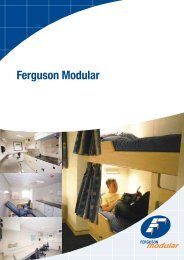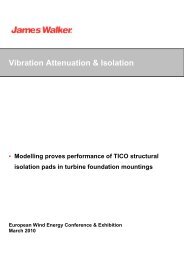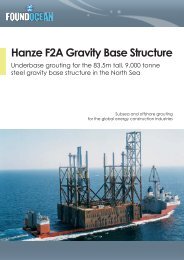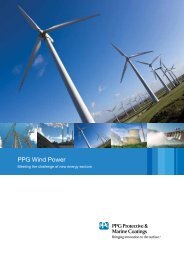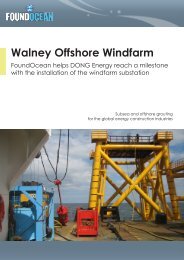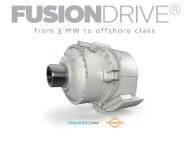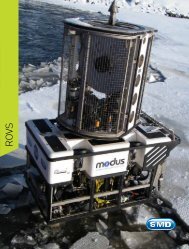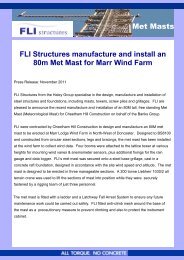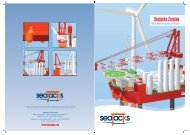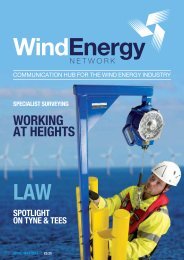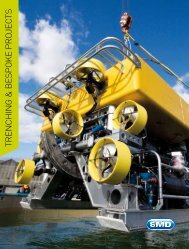JUNE/JULY 2013 | £5.25 - Wind Energy Network
JUNE/JULY 2013 | £5.25 - Wind Energy Network
JUNE/JULY 2013 | £5.25 - Wind Energy Network
Create successful ePaper yourself
Turn your PDF publications into a flip-book with our unique Google optimized e-Paper software.
LubricantsLubricantsPerfect balance?how to improve turbine reliabilitywithout it costing the earthIn an environment where downtime for even one turbinecan cost thousands, it is crucial that wind farm operatorsensure they can rely on their equipment.At the same time, across theindustry there is a big drivetowards reducing cost andmaking wind energy moreprofitable and competitive toconventional energy sources.<strong>Wind</strong> turbines are certainlybecoming cheaper, and for somewind farm projects manufacturersare just breaking even on theturbine assets to gain the moreprofitable service business, whichcan last anything up to 20 years.Some estimates are that the industry is cutting out up to 30per cent of its operating costs through reducing downtime andimproving efficiency of turbines in order to drive better profits,with the ultimate aim of becoming a mainstream, widely usedpower source.While this is all good news, it means that there is more pressurethan ever on wind farms to cut costs, without compromisingoutput. It shouldn’t be the case that more reliable equipment costsmore. In fact in this situation, cost andreliability of equipment go hand in hand.<strong>Wind</strong> turbines need to be performing aseffectively as possible, and wind farmoperators need to be confident they canrely on them in order to drive down costsacross the board.How to ensure reliabilityThe best way to achieve a balancebetween cost and reliability is to ensureturbines are running regularly, withoutpushing the equipment to produceevery last possible energy output.Imagine you have two cars next to eachother at a set of traffic lights – one revshis engine and speeds off as soon as the lights change, anotherdrives away slowly but surely. It doesn’t take an engineer to workout which of these two car engines will last longer.The same logic can be applied to wind turbines – while somewind farms will push a turbine to produce every last megawattas quickly as possible, other operators will take a ‘slowly butsurely’ approach. In the same way that both drivers at the trafficlights will probably arrive home at the same time, the turbines willproduce similar amounts of power, but a more steady approachpreserves the life of the turbine, which ultimately saves money.The obvious advantage of this is that if the lubricant isperforming well, it won’t need changing which savessubstantial costs.The decision is made about whether to change the oil basedon a small sample being taken, and the condition of the oilbeing judged from that. This is a trend we fully support hereat Castrol Industrial as it saves both cost and waste, and wehave developed a number of diagnostic tools such as CastrolLabCheck and Castrol Predict, to help operators make thisdecision.It’s important to remember that some specialist lubricants alsohave the capacity to repair damage caused to gearboxes –micropitting and bearing failure rank as the highest cause ofdowntime, and having a lubricant to address these problemscan save money in the long term.Ultimately, the right choice of lubricant can extend the lifeof gearboxes and the turbines they run, which obviouslyrepresents substantial cost savings.Future industry growthThe pressure to reduce cost has bought about many changeswithin the wind industry. However we shouldn’t be afraid ofthis – operators should embrace these changes and workwith suppliers to create wind farms that are as cost effectiveand reliable as possible.To ensure they have optimum reliability combined with costsavings, wind farm operators should take into account bothhow they operate the wind turbines and the performance ofthe lubricants they’re using to drive them.These significant trends in the wind business will in time growthe industry and increase consumption of wind power acrossthe board, which in the long term can only be a good thing forall of us.charter@tidal-transit.comtidal-transit.comUnit 2 Docking Rural Workshops, Station Road, Docking, Norfolk PE31 8LT Tel: +44 1485 518 760Avoiding wear and tearIn line with this trend towards preserving turbine life to ensurecosts are kept down and profits are increased, lubricantmanufacturers are working hand in hand with the industry toextend the life of gear oils and bearing greases, so downtimecaused by oil changes is kept to a minimum. The technology maybe some way off, but ultimately why shouldn’t a gear oil last aslong as the gears it lubricates?Sven ThiesenGlobal Key Account ManagerCastrol Industrialwww.castrol.comOne trend in the market at the moment has the potential to havea substantial impact on running costs. O&M Teams are movingaway from fixed oil change intervals to ‘condition-based’ oilchanges – essentially only changing the oil when necessary.84 www.windenergynetwork.co.ukwww.windenergynetwork.co.uk 85



